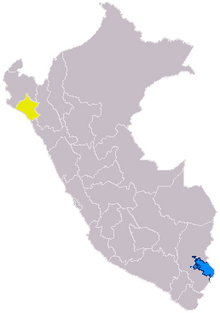
Back حضارة سيكان Arabic Sicán-Kultur German Cultura lambayeque Spanish تمدن سیکان Persian Sicán Finnish Lambayeque (culture) French Cultura Sican Italian シカン文化 Japanese Sikano kultūra Lithuanian Sicáncultuur Dutch
 Map of the Sican culture (yellow)[citation needed] | |
| Geographical range | Lambayeque |
|---|---|
| Period | Middle Horizon Late Intermediate |
| Dates | c. 750 - 1375 |
| Preceded by | Moche |
| Followed by | Chimor |

The Sican (also Sicán) culture is the name that archaeologist Izumi Shimada gave to the culture that inhabited what is now the north coast of Peru between about 750 and 1375 CE. According to Shimada, Sican means "temple of the Moon".[1] The Sican culture is also referred to as Lambayeque culture, after the name of the region in Peru. It succeeded the Moche culture. There is still controversy among archeologists and anthropologists over whether the two are separate cultures. The Sican culture is divided into three major periods based on cultural changes as evidenced in archeological artifacts.[2]
- ^ Described by Izumi Shimada in the TV program, Hitachi Fushigi Hakken! (ja:日立 世界・ふしぎ発見!; "Discover!" World Wonder sponsored by Hitachi"), 8 August 2009.
- ^ "Research Settings: The Sican Culture". Archived from the original on 2008-11-20.
{{cite web}}: CS1 maint: unfit URL (link), Sican Archaeological Project (SAP), 2007, Retrieved 5 October 2008.